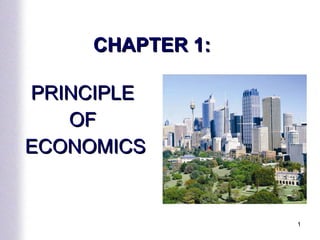
Chap1
- 1. CHAPTER 1: PRINCIPLE OF ECONOMICS
- 2. 1.1 Introduction 1.2 Economics Defined 1.3 The Scope of Economics 1.4 Scarcity, Choices & Opportunity cost 1.5 Basic Economic Problems 1.6 Production Possibility Frontier (PPF) 1.6 Economic System CHAPTER OUTLINE
- 4. 1.2 ECONOMIC DEFINED Economics: a) K.E. Case and R. C. Fair view that economics is a study of how people use their limited resources to try to fulfill unlimited wants and involves alternatives or choices. b) David N. Hyman defined economics as a study of how scarce resources are allocated among alternative uses c) Economics is a science that studies human behavior as a relationship between ends and scarce , which have alternative uses, according to L. Robbins
- 6. Scarcity : The core problem Choice Opportunity cost Danny has RM5 and he would like to buy two things; a book and a pen which cost RM5 each (unlimited wants and limited resources). Danny has to choose either to purchase book or a pen which would satisfy his needs (choices) . If Danny choose the book, then the pen is the opportunity cost . 1.4 SCARCITY, CHOICES AND OPPORTUNITY COST
- 17. Shifts in the Economy’s Production Possibilities Frontier
- 22. 1.7 ECONOMIC SYSTEMS Free Market Economy Mixed Economy Planned Economy ECONOMIC SYSTEMS
- 25. Figure 1 illustrated the Production Possibility Frontier (PPF) for the allocation of resources in Malaysian banking sector. Assumed that the Malaysian banking sector only consist of two types of banking product/services that are the conventional banking and Islamic banking. Example of PPF analysis
- 26. Example of PPF analysis End Point on PPF Opportunity cost (Ringgit of conventional outputs per one Ringgit of Islamic banking output) (i) A to B (ii) B to C (iii) C to D
- 27. Scenario A : Malaysian is currently producing at Point B. The government is encouraging the development of Islamic banking , thus, advising all the banks in Malaysia to divert more resources to Islamic banking from conventional banking. If all the banks follow the government’s advice, sketch a PPF diagram to illustrate this scenario. Mark a possible new production combination (point) as “E”. Give your explanation.
- 28. Scenario B : The government successfully invites foreign Islamic banks to invest in Malaysia by opening branches here. What happen to the PPF? Mark a new possible production point as “F”. Give your explanation.
- 29. THANK YOU
